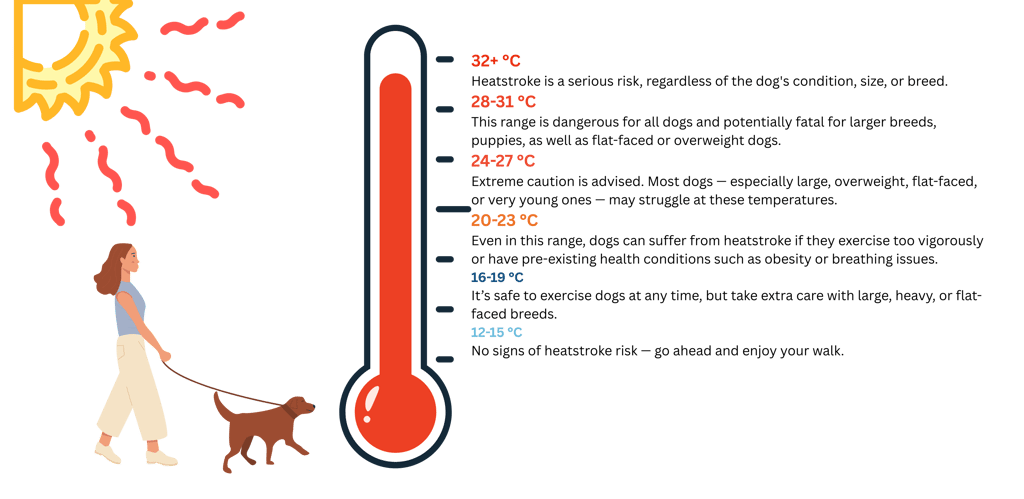Summer and Heatstroke: The Breeds Most at Risk and How to Protect Them
As summer approaches, pay attention to signs of discomfort in your dog: difficulty breathing, fatigue, and excessive panting. Which breeds are at risk? Take walks during the cooler hours, avoid hot asphalt, and always make sure to have fresh water with you. For extra protection, try the VOFFWEAR cooling vest!
ENG
5/3/20253 min read


Summer and Heatstroke: The Breeds Most at Risk and How to Protect Them
With the summer heat, it is very important to keep an eye on your dog. If you notice any of the following signs, contact your vet immediately:
Difficulty breathing or excessive panting
Excessive salivation
Dry gums or abnormal color changes
Fatigue or lethargy
Dizziness or vomiting
Which Dogs Are at Greater Risk?
Some dog breeds are more vulnerable to heat due to their genetic traits, coat type, muzzle shape, and health conditions. Here are some breeds that are particularly sensitive to high temperatures:
Pug (20°C): Their short muzzles make them vulnerable to heat.
French Bulldog (21°C): Their short muzzles and flat faces make breathing in the heat difficult.
English Bulldog (21°C): This breed tires quickly and struggles in hot conditions.
Boston Terrier (22°C): Due to their short muzzles, they tire quickly and have difficulty breathing in the heat.
Shih Tzu (22°C): Their long coat and flat muzzle can cause difficulties on hot days.
Maltese (22°C): Their long coat and small size make them more vulnerable to heat.
Boxer (23°C): Their high energy and short muzzles make them more sensitive to heat.
Cavalier King Charles Spaniel (23°C): Their small size and long coat make it harder to keep them cool.
Schnauzer (mini and standard) (24°C): Their thick coat can cause difficulty on hot days.
Bulldog (24°C): This breed has short muzzles and can overheat quickly.
Chihuahua (24°C): Due to their small size, they tire quickly in the heat.
Yorkshire Terrier (24°C): Their small size and thin coat can make it difficult to stay cool.
Dachshund (24°C): Their small size and short legs make them less comfortable in the heat.
Lhasa Apso (24°C): Their long coat can cause discomfort in the heat.
Shiba Inu (25°C): Their thick coat can be problematic on hot days.
Pomeranian (25°C): Their small size and thick coat make them more sensitive to heat.
Cocker Spaniel (25°C): Their long coat makes them more prone to overheating on hot days.
Samoyed (26°C): Their thick and dense coat makes them vulnerable to heat.
Husky (26°C): Being a northern breed, their thick coat makes them more susceptible to high temperatures.
Alaskan Malamute (27°C): Another breed with a thick coat that can struggle with the heat.
Other Dogs: Medium Size and Resilience
Medium-sized dogs are generally more resilient, but you should still be cautious with the heat. Their coat type, genetic traits, and health conditions should always be considered.


Factors to Consider When Taking Your Dog for a Walk in the Heat:
When taking your dog for a walk, factors like age, size, breed, and health conditions need to be considered. Here are some important points:
Age: Puppies are less tolerant of extreme temperatures than adult dogs. Older dogs are also more at risk for heat-related injuries.
Size: Small breeds are more sensitive to both heat and cold, while medium and large breeds are generally more resilient.
Breed: Breeds with short muzzles, like French Bulldogs, Pugs, and Boston Terriers, are particularly sensitive to temperature changes.
Coat type: Dogs with thick double coats (like Huskies and Malamutes) can tolerate cold better but may have trouble with heat.
Health conditions: Even in moderate temperatures (around 20°C), some dogs with health conditions such as heart disease, breathing problems, obesity, and hypothyroidism are more prone to heatstroke.
Weather conditions: Even if the temperature isn’t extreme, wind can make the air feel colder, or humidity can make it harder for your dog to stay cool.
Summer Safety Tips:
Here are some additional tips to help keep your dog cool and safe during the summer:
Walk during cooler hours: Early mornings or evenings are generally cooler. If walking at night, make sure your dog wears reflective clothing for visibility.
Check the asphalt temperature: Place your hand on the ground to check the temperature. If it’s too hot for your hand, it’s too hot for your dog’s paws. Consider having your dog walk with protective shoes.
Walk in shaded areas: Try to walk near water or in shaded areas to help your dog stay cool.
Reduce walk distance and pace: Make walks shorter and slower to avoid exhaustion in the heat.
Provide plenty of water: Make sure your dog stays hydrated by offering water frequently during the walk. You can use portable water bottles or travel bowls.
Give your dog fresh water when you return home: To help them cool down, offer fresh water or use a cooling mat or frozen toys.
Consider buying a Voffwear Cooling Vest! It’s a great solution to help your dog stay cool during hot days.
*Not a substitute for professional veterinary help.
Join the Pack
© 2025. All rights reserved. Voffwear - VAT IT13950740962
Serve Aiuto?
Voffwear


